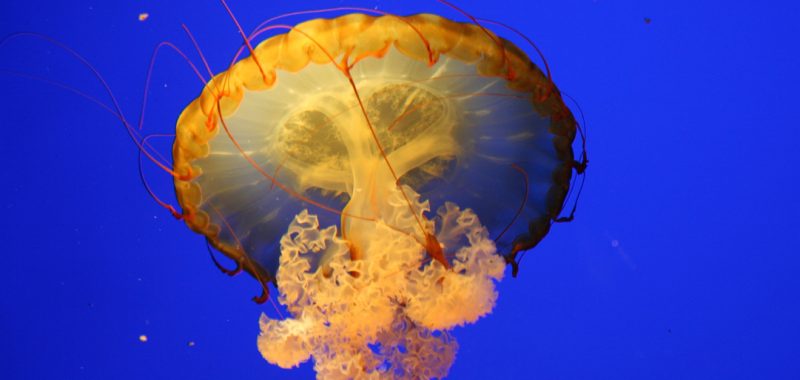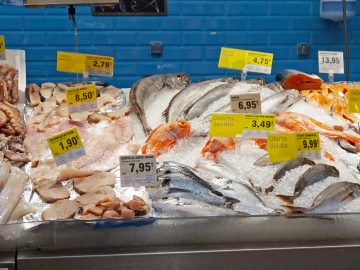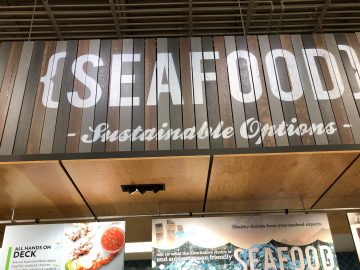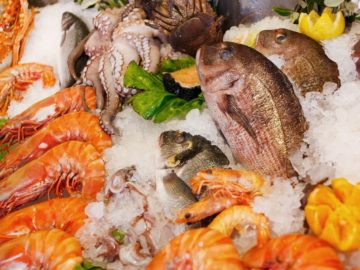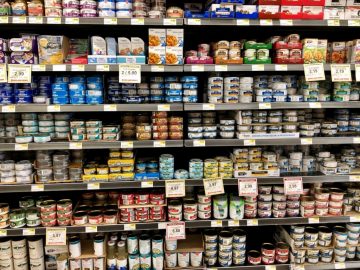Most retailers are resisting publishing their procurement information or labelling their seafood products better.
At the start of July, SeaChoice released our first annual update to Seafood Progress – an online resource that assesses and compares major Canadian food retailers’ sustainable seafood commitments and what they are doing to achieve them. Seafood Progress has six steps that follow the framework produced by the Conservation Alliance for Seafood Solutions in their Common Vision for Sustainable Seafood. This post is the fourth in a series that looks at each of the six steps in more detail, highlighting trends, shortcomings and leaders in action.
The three previous posts reviewed how retailers scored on their Commitments, Data Collection policies, and on their Responsible Sourcing practices – this post looks at how transparent retailers are in terms of seafood labelling, where their seafood is coming from and how it is produced, and how much of the seafood they sell meets their sustainability criteria.
The national mean (average) for Step 4 went up by 17 points this year to 68 (out of 100), with the biggest jump coming from increased frequency of retailers reporting how much of the seafood they procured met their sustainability policy or commitment. Part of this increased frequency is due to retailers disclosing progress against their commitment last year through Seafood Progress, or disclosing for the first time this year. The average score for using eco-labels on seafood products to indicate they are either from eco-certified sources (e.g. the Marine Stewardship Council) or have been assessed by ranking or recommendation programs (e.g. Ocean Wise) was also high, jumping from 73 to 94.
However, this year saw only a small increase (from 35 to 41 out of 100) in the average seafood labelling practices of major retailers. Canada’s labelling laws only require that retailers use a common or market name on their seafood products, and sometimes the country of origin if the product has been imported. This is not nearly enough information for seafood consumers to know what they are actually eating (most common names can be used with multiple species, for example “snapper”, which can be used on over 200 species), where it was caught or farmed, or what methods were used to catch or farm it. And this information is crucial to determine how environmentally sustainable the product is and whether it is a healthy choice for people who need to be careful what they eat. SeaChoice commends METRO for achieving a labelling score of 100 for the second year in a row, labelling all of its fresh, frozen and private label products (except for seafood in frozen bulk bins) with species scientific names, where it was caught/farmed, whether it was wild or farmed, and the gear or method used to produce it. We encourage other retailers to voluntarily adopt a policy of better seafood labelling quality.
Another low scoring element of this step is transparency of procurement information, like which fisheries or farming areas retailers’ seafood products come from. However, the 2019 average of 13 (out of 100) is better than the zero it was last year, thanks to recent initiatives from METRO and Walmart Canada. METRO has made information on the region and gear type data available for many its wild caught and farmed products through its new public information platform – “Fraîcheur traçable” / “Freshness you can trace“. Using this system and the information available on seafood counter and private label products, customers can find out where products are from and what gear or farming method was used to produce them. Walmart Canada used the Ocean Disclosure Program to publish the species name and location, production method, stock status and management system, and whether the fishery is certified or in a registered improvement project for their wild-caught fresh and frozen products.
One of the main goals of Seafood Progress is to increase the transparency of major Canadian retailer’s sustainable seafood policies and their actions against those policies, so we are pleased to report that the average step score for Transparency went up almost 50% in one year. This shows that retailers are responding to their customers’ demands for more information and openness. SeaChoice recognizes the hard work and courage of the retailers who have shown themselves to be leaders on this issue. However, there is still significant room for improvement, especially from the four retailers which are scoring less than 50 on this important issue.
Others in this series:
